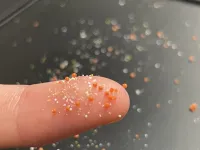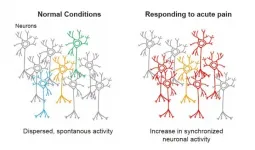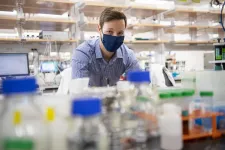(Press-News.org) It's estimated that an average-sized wastewater treatment plant serving roughly 400,000 residents will discharge up to 2,000,000 microplastic particles into the environment each day. Yet, researchers are still learning the environmental and human health impact of these ultra-fine plastic particles, less than 5 millimeters in length, found in everything from cosmetics, toothpaste and clothing microfibers, to our food, air and drinking water.
Now, researchers at New Jersey Institute of Technology have shown that ubiquitous microplastics can become 'hubs' for antibiotic-resistant bacteria and pathogens to grow once they wash down household drains and enter wastewater treatment plants -- forming a slimy layer of buildup, or biofilm, on their surface that allows pathogenic microorganisms and antibiotic waste to attach and comingle.
In findings published in Elsevier's Journal of Hazardous Materials Letters, researchers found certain strains of bacteria elevated antibiotic resistance by up to 30 times while living on microplastic biofilms that can form inside activated sludge units at municipal wastewater treatment plants.
"A number of recent studies have focused on the negative impacts that millions of tons of microplastic waste a year is having on our freshwater and ocean environments, but until now the role of microplastics in our towns' and cities' wastewater treatment processes has largely been unknown," said Mengyan Li, associate professor of chemistry and environmental science at NJIT and the study's corresponding author. "These wastewater treatment plants can be hotspots where various chemicals, antibiotic-resistant bacteria and pathogens converge and what our study shows is that microplastics can serve as their carriers, posing imminent risks to aquatic biota and human health if they bypass the water treatment process."
"Most wastewater treatment plants are not designed for the removal of microplastics, so they are constantly being released into the receiving environment," added Dung Ngoc Pham, NJIT Ph.D. candidate and first author of the study. "Our goal was to investigate whether or not microplastics are enriching antibiotic-resistant bacteria from activated sludge at municipal wastewater treatment plants, and if so, learn more about the microbial communities involved."
In their study, the team collected batches of sludge samples from three domestic wastewater treatment plants in northern New Jersey, inoculating the samples in the lab with two widespread commercial microplastics -- polyethylene (PE) and polystyrene (PS). The team used a combination of quantitative PCR and next-generation sequencing techniques to identify the species of bacteria that tend to grow on the microplastics, tracking genetic changes of the bacteria along the way.
The analysis revealed that three genes in particular -- sul1, sul2 and intI1-- known to aid resistance to common antibiotics, sulfonamides, were found to be up to 30 times greater on the microplastic biofilms than in the lab's control tests using sand biofilms after just three days.
When the team spiked the samples with the antibiotic, sulfamethoxazole (SMX), they found it further amplified the antibiotic resistance genes by up to 4.5-fold.
"Previously, we thought the presence of antibiotics would be necessary to enhance antibiotic-resistance genes in these microplastic-associated bacteria, but it seems microplastics can naturally allow for uptake of these resistance genes on their own." said Pham. "The presence of antibiotics does have a significant multiplier effect however."
Eight different species of bacteria were found highly enriched on the microplastics. Among these species, the team observed two emerging human pathogens typically linked with respiratory infection, Raoultella ornithinolytica and Stenotrophomonas maltophilia, frequently hitchhiking on the microplastic biofilms.
The team say the most common strain found on the microplastics by far, Novosphingobium pokkalii, is likely a key initiator in forming the sticky biofilm that attracts such pathogens -- as it proliferates it may contribute to the deterioration of the plastic and expand the biofilm. At the same time, the team's study highlighted the role of the gene, intI1, a mobile genetic element chiefly responsible for enabling the exchange of antibiotic resistance genes among the microplastic-bound microbes.
"We might think of microplastics as tiny beads, but they provide an enormous surface area for microbes to reside," explained Li. "When these microplastics enter the wastewater treatment plant and mix in with sludge, bacteria like Novosphingobium can accidentally attach to the surface and secrete glue-like extracellular substances. As other bacteria attach to the surface and grow, they can even swap DNA with each other. This is how the antibiotic resistance genes are being spread among the community."
"We have evidence that the bacteria developed resistance to other antibiotics this way as well, such as aminoglycoside, beta-lactam and trimethoprim," added Pham.
Now, Li says the lab is further studying the role of Novosphingobium in biofilm formation on microplastics. The team is also seeking to better understand the extent to which such pathogen-carrying microplastics may be bypassing water treatment processes, by studying resistance of microplastic biofilms during wastewater treatment with disinfectants such as UV light and chlorine.
"Some states are already considering new regulations on the use of microplastics in consumer products. This study raises calls for further investigation on microplastic biofilms in our wastewater systems and development of effective means for removing microplastics in aquatic environments," said Li.
INFORMATION:
ROCHESTER, Minn. -- Low representation of minority groups in public genomic databases may affect therapy selection for Black patients with cancer, according to new Mayo Clinic research published in npj Precision Oncology.
The researchers investigated the use of genomic databases and found that tumor mutation burden was significantly inflated in Black patients compared to White patients.
As a result of the study, clinicians who are using public genomic databases need to be aware of the potential for inflated tumor mutation burden values and how that may affect therapy selection and outcomes, especially for patients from underrepresented groups.
Clinicians use biomarkers, which are indicators of a disease or condition, to determine ...
BOSTON - Researchers have used a genetic engineering strategy to dramatically reduce levels of tau--a key protein that accumulates and becomes tangled in the brain during the development of Alzheimer's disease--in an animal model of the condition. The results, which come from investigators at Massachusetts General Hospital (MGH) and Sangamo Therapeutics Inc., could lead to a potentially promising treatment for patients with this devastating illness.
As described in Science Advances, the strategy involves a gene regulation technology called zinc finger protein transcription ...
A team of scientists, led by researchers at Northwestern University, Shirley Ryan AbilityLab and the University of Illinois at Chicago (UIC), has developed novel technology promising to increase understanding of how brains develop, and offer answers on repairing brains in the wake of neurotrauma and neurodegenerative diseases.
Their research is the first to combine the most sophisticated 3-D bioelectronic systems with highly advanced 3-D human neural cultures. The goal is to enable precise studies of how human brain circuits develop and repair themselves in vitro. The study is the cover story for ...
In a world first, a cross-institutional research collaboration has used a two-photon microscope (*1) with a combination of calcium imaging (*2) and holographic stimulation (*3) to reveal that the functional connectivity between neurons located in the primary somatosensory cortex is increased in response to acute pain.
Pain occurs as a result of injury, such as peripheral neuron damage or inflammation stemming from peripheral tissue violation. Research findings have been published on the involvement of central nervous system abnormalities in the onset of pain and sustained pain. The primary somatosensory cortex ...
COLUMBUS, Ohio - Most stroke victims don't receive treatment fast enough to prevent brain damage. Scientists at The Ohio State University Wexner Medical Center, College of Engineering and College of Medicine have developed technology to "retrain" cells to help repair damaged brain tissue. It's an advancement that may someday help patients regain speech, cognition and motor function, even when administered days after an ischemic stroke.
Engineering and medical researchers use a process created by Ohio State called tissue nanotransfection (TNT) to introduce genetic material into cells. This allows them to reprogram skin cells to become something ...
New York, NY--March 19, 2020--Columbia Engineering researchers, working with Brookhaven National Laboratory, report today that they have built designed nanoparticle-based 3D materials that can withstand a vacuum, high temperatures, high pressure, and high radiation. This new fabrication process results in robust and fully engineered nanoscale frameworks that not only can accommodate a variety of functional nanoparticle types but also can be quickly processed with conventional nanofabrication methods.
"These self-assembled nanoparticles-based materials are so resilient that they could fly in space," says Oleg Gang, professor ...
PITTSBURGH, March 19, 2021 - Non-circulating memory T cells, whose main function is to provide local protection against re-infection, contribute to chronic transplant rejection, University of Pittsburgh School of Medicine researchers reveal in a paper published today in Science Immunology.
The scientists show that these "tissue-resident memory T cells" are harmful in situations where antigens that the cells recognize are present in the body for a long time, such as in cases of an organ or tissue transplant. This finding is an important step toward improving therapies to help prevent organ rejection in transplant recipients.
"Tissue-resident memory T cells serve an important surveillance function," said co-senior author Martin Oberbarnscheidt, ...
CAMBRIDGE, MA -- Many viruses infect their hosts through mucosal surfaces such as the lining of the respiratory tract. MIT researchers have now developed a vaccination strategy that can create an army of T cells that are ready and waiting at those surfaces, offering a quicker response to viral invaders.
The researchers showed that they could induce a strong memory T cell response in the lungs of mice by giving them a vaccine modified to bind to a protein naturally present in mucus. This can help ferry the vaccine across mucosal barriers, such as the lining of the lungs.
"In this paper, we specifically focused on T cell responses that would be useful against viruses or cancer, and our idea was to use this protein, albumin, as sort of a Trojan horse to ...
To understand the fundamental properties of an industrial solvent, chemists with the University of Cincinnati turned to a supercomputer.
UC chemistry professor and department head Thomas Beck and UC graduate student Andrew Eisenhart ran quantum simulations to understand glycerol carbonate, a compound used in biodiesel and as a common solvent.
They found that the simulation provided detail about hydrogen bonding in determining the structural and dynamic properties of the liquid that was missing from classical models. The study was published in the Journal of Physical Chemistry B.
Glycerol carbonate could be a more environmentally ...
During a public health crisis like the COVID-19 pandemic, U.S. hospitals need to allocate scarce medical resources in an equitable manner, according to clinicians and ethicists at the University of Miami Miller School of Medicine.
"Significant concerns have been raised that crisis standards of care may be biased against certain patients based on race or ethnicity," said Hayley Gershengorn, M.D., associate professor of pulmonary and critical care medicine. "To examine that issue, we analyzed over a thousand medical records from two academic hospitals where University of Miami faculty see patients and found no disparities ...





